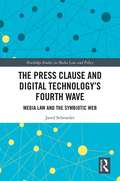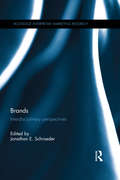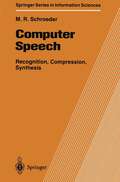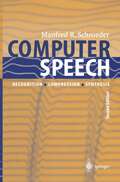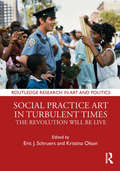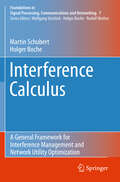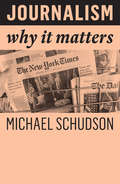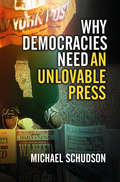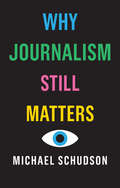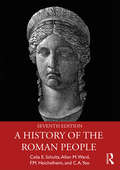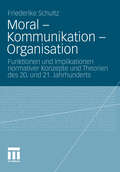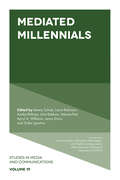- Table View
- List View
Hacking für Manager: Was Manager über IT-Sicherheit wissen müssen. Die Tricks der Hacker.
by Tobias SchrödelDie Technik, die uns heute überschwemmt, lässt uns gar keine Chance mehr, alles so abzusichern, dass wir auch wirklich sicher sind. Lernen Sie die Waffen Ihrer Gegner und Ihre eigenen Abwehrmöglichkeiten kennen. Aber keine Sorge, bei diesem Blick in den Giftschrank der IT müssen Sie bei Leibe kein Computerfachmann oder IT Profi sein.
Einheiten und Symbole für Ingenieure: Ein Überblick (essentials)
by Bernd SchröderTechnische Kommunikation ist auf einvernehmliche Bedeutung von Einheiten angewiesen. Hierfür bietet das Système International (SI) eine weitgehend anerkannte Basis, die hier vorgestellt wird. Die entsprechenden Größen und Einheiten sind aufgelistet und abgeleitete Werte nach Themengebieten zusammengefasst. Auch Größen und Einheiten außerhalb von SI sind aufgeführt. Ergänzend werden kurz die römischen Zahlen und griechischen Buchstaben vorgestellt.
Kunststoffe für Ingenieure: Ein Überblick (essentials)
by Bernd SchröderFür die Auswahl geeigneter Kunststoffe ist es hilfreich, die physikalisch-technischen Eigenschaften der Materialien zu kennen. Entsprechend den Gruppen Duroplaste, Thermoplaste, Elastomere und Schäume werden die Eigenschaften aufgelistet und Anwendungsbereiche erläutert.
Steuerungstechnik für Ingenieure: Ein Überblick (essentials)
by Bernd SchröderFür selbstarbeitende und automatisierte (Produktions-) Prozesse werden Steuerungstechniken genutzt. Die hierzu eingesetzten Elemente arbeiten mechanisch, pneumatisch, hydraulisch, elektrisch oder elektronisch. Ausführende Organe sind unter anderem Ventile, Pumpen, Motore, Schalter, Sensoren und Relais. Die hierfür gängigen Symbole werden vorgestellt und können in Schemata eingesetzt werden. Gelegentlich ist die Erstellung sequenzieller Schaltungen hilfreich. Für eine hohe Flexibilität bietet sich die speicherprogrammierbare Steuerung (SPS) an.
Technisches Zeichnen für Ingenieure: Ein Überblick (essentials)
by Bernd SchröderMaschinenbauliche und bautechnische Zeichnungen legen die zu erstellenden Objekte fest. Um diese Zeichnungen eindeutig zu gestalten, wurde ein umfangreiches Normenwerk etabliert, in welchem Grundnormen und Zeichnungsarten vereinbart sind. Formate, Maßstäbe und Ansichten werden vorgestellt, ebenso wie Linien und Darstellungen (Linienarten, Buchstaben, Ziffern und Schrift). Schraffur und Bemaßung sind ebenfalls aufgeführt. Für bautechnische Zeichnungen wird die Darstellung von Baumaterialien gezeigt, aber auch Bauelemente. Beim werkzeugbaulichen Zeichnen interessieren die technischen Oberflächen und Rauheitsbezeichnungen, Grenzmaße und Passungen. Auch Schweißbezeichnungen gehören dazu oder Muster von Bearbeitungsspuren. Für technische Systeme werden Stücklisten behandelt. Form- und Lagetoleranzen sichern die geometrische Genauigkeit des zu fertigenden Bauteils.
Brasilianische und deutsche Wirklichkeiten: Eine vergleichende Fallstudie zu kommunikativ erzeugten Sinnwelten (Verhandlung der Deutschen Gesellschaft Rheumatologie)
by Ulrike SchröderUlrike Schröder zeigt, wie sich Wirklichkeitsauffassungen, Sprechstil und Kulturgeschichte wechselseitig bedingen. Zentrale These ist, dass die Wirklichkeiten, in denen wir leben, kommunikativ erzeugt sind, so dass es, bedingt durch die unterschiedlichen Standorte, von denen aus Menschen kommunikativ handeln, auch zu verschiedenen Wirklichkeitskonstrukten kommt.
The Press Clause and Digital Technology's Fourth Wave: Media Law and the Symbiotic Web (Routledge Studies in Media Law and Policy)
by Jared SchroederDuring the first part of the twenty-first century, bloggers, citizen journalists, social media users, Yelp reviewers, and a myriad of other communicators have found themselves facing defamation, privacy, campaign finance, and other lawsuits as a result of the messages they have communicated. In many ways, these communicators are facing legal questions that are similar to what traditional journalists have faced for centuries regarding their rights to gather and publish information. This book examines how the press clause, a First Amendment freedom with no agreed-upon definition, can be understood in order to help guide the courts and twenty-first-century publishers regarding protecting expression as we move into the fourth wave of networked communication, an era that will be defined by increasingly complex relationships between humans and artificially intelligent communicators. To do so, the book draws upon the discourse theory of communication in democratic society, the legal and foundational history of the press clause, lower-court cases that involve citizen publishers who have claimed protections that have historically been associated with traditional journalism, and established legal and scholarly examinations of artificial intelligence to ultimately construct a framework for how the press clause can be reimagined to protect older and newer generations of publishers.
The Press Clause and Digital Technology's Fourth Wave: Media Law and the Symbiotic Web (Routledge Studies in Media Law and Policy)
by Jared SchroederDuring the first part of the twenty-first century, bloggers, citizen journalists, social media users, Yelp reviewers, and a myriad of other communicators have found themselves facing defamation, privacy, campaign finance, and other lawsuits as a result of the messages they have communicated. In many ways, these communicators are facing legal questions that are similar to what traditional journalists have faced for centuries regarding their rights to gather and publish information. This book examines how the press clause, a First Amendment freedom with no agreed-upon definition, can be understood in order to help guide the courts and twenty-first-century publishers regarding protecting expression as we move into the fourth wave of networked communication, an era that will be defined by increasingly complex relationships between humans and artificially intelligent communicators. To do so, the book draws upon the discourse theory of communication in democratic society, the legal and foundational history of the press clause, lower-court cases that involve citizen publishers who have claimed protections that have historically been associated with traditional journalism, and established legal and scholarly examinations of artificial intelligence to ultimately construct a framework for how the press clause can be reimagined to protect older and newer generations of publishers.
Brands: Interdisciplinary Perspectives (Routledge Interpretive Marketing Research)
by Jonathan E. SchroederBranding has emerged as a cornerstone of marketing practice and corporate strategy, as well as a central cultural practice. In this book, Jonathan Schroeder brings together a curated selection of the most influential and thought-provoking papers on brands and branding from Consumption Markets and Culture, accompanied by new contributions from leading brand scholars Giana Eckhardt, John F. Sherry, Jr., Sidney Levy and Morris Holbrook. Organised into four perspectives – cultural, corporate, consumer, critical - these papers are chosen to highlight the complexities of contemporary branding through leading consumer brands such as Disney, eBay, Guinness, McDonalds, Nike, and Starbucks. They address key topics such as celebrity branding, corporate branding, place branding, and retail branding and critique the complexities of contemporary brands to provide a rich trove of interdisciplinary research insights into the function of brands as ethical, ideological and political objects. This thought-provoking collection will be of interest to all scholars of marketing, consumer behaviour, anthropology and sociology, and anyone interested in the powerful roles brands play in consumer’s lives and cultural discourse.
Brands: Interdisciplinary Perspectives (Routledge Interpretive Marketing Research)
by Jonathan E. SchroederBranding has emerged as a cornerstone of marketing practice and corporate strategy, as well as a central cultural practice. In this book, Jonathan Schroeder brings together a curated selection of the most influential and thought-provoking papers on brands and branding from Consumption Markets and Culture, accompanied by new contributions from leading brand scholars Giana Eckhardt, John F. Sherry, Jr., Sidney Levy and Morris Holbrook. Organised into four perspectives – cultural, corporate, consumer, critical - these papers are chosen to highlight the complexities of contemporary branding through leading consumer brands such as Disney, eBay, Guinness, McDonalds, Nike, and Starbucks. They address key topics such as celebrity branding, corporate branding, place branding, and retail branding and critique the complexities of contemporary brands to provide a rich trove of interdisciplinary research insights into the function of brands as ethical, ideological and political objects. This thought-provoking collection will be of interest to all scholars of marketing, consumer behaviour, anthropology and sociology, and anyone interested in the powerful roles brands play in consumer’s lives and cultural discourse.
Computer Speech: Recognition, Compression, Synthesis (Springer Series in Information Sciences #35)
by Manfred R. SchroederNew material treats such contemporary subjects as automatic speech recognition and speaker verification for banking by computer and privileged (medical, military, diplomatic) information and control access. The book also focuses on speech and audio compression for mobile communication and the Internet. The importance of subjective quality criteria is stressed. The book also contains introductions to human monaural and binaural hearing, and the basic concepts of signal analysis. Beyond speech processing, this revised and extended new edition of Computer Speech gives an overview of natural language technology and presents the nuts and bolts of state-of-the-art speech dialogue systems.
Computer Speech: Recognition, Compression, Synthesis (Springer Series in Information Sciences #35)
by Manfred R. SchroederNew material treats such contemporary subjects as automatic speech recognition and speaker verification for banking by computer and privileged (medical, military, diplomatic) information and control access. The book also focuses on speech and audio compression for mobile communication and the Internet. The importance of subjective quality criteria is stressed. The book also contains introductions to human monaural and binaural hearing, and the basic concepts of signal analysis. Beyond speech processing, this revised and extended new edition of Computer Speech gives an overview of natural language technology and presents the nuts and bolts of state-of-the-art speech dialogue systems.
Social Practice Art in Turbulent Times: The Revolution Will Be Live (Routledge Research in Art and Politics)
by Eric J. Schruers Kristina OlsonThis volume is an anthology of current groundbreaking research on social practice art. Contributing scholars provide a variety of assessments of recent projects as well as earlier precedents, define approaches to art production, and provide crucial political context. The topics and art projects covered, many of which the authors have experienced firsthand, represent the work of innovative artists whose creative practice is utilized to engage audience members as active participants in effecting social and political change. Chapters are divided into four parts that cover history, specific examples, global perspectives, and critical analysis.
Interference Calculus: A General Framework for Interference Management and Network Utility Optimization (Foundations in Signal Processing, Communications and Networking #7)
by Martin Schubert Holger BocheThis book develops a mathematical framework for modeling and optimizing interference-coupled multiuser systems. At the core of this framework is the concept of general interference functions, which provides a simple means of characterizing interdependencies between users. The entire analysis builds on the two core axioms scale-invariance and monotonicity. The proposed network calculus has its roots in power control theory and wireless communications. It adds theoretical tools for analyzing the typical behavior of interference-coupled networks. In this way it complements existing game-theoretic approaches. The framework should also be viewed in conjunction with optimization theory. There is a fruitful interplay between the theory of interference functions and convex optimization theory. By jointly exploiting the properties of interference functions, it is possible to design algorithms that outperform general-purpose techniques that only exploit convexity. The title “network calculus” refers to the fact that the theory of interference functions constitutes a generic theoretical framework for the analysis of interference coupled systems. Certain operations within the framework are “closed”, that is, combinations of interference functions are interference functions again. Also, certain properties are preserved under such operations. This, provides a methodology for analyzing different multiuser performance measures that can be expressed as interference functions or combinations of interference functions.
Journalism: Why It Matters (Why It Matters)
by Michael SchudsonDespite the criticisms that have been leveled at news organizations in recent years and the many difficulties they face, journalism matters. It matters, argues Schudson, because it orients people daily in the complex and changing worlds in which they live. It matters because it offers a fact-centered, documented approach to pertinent public issues. It matters because it keeps watch on the powerful, especially those in government, and can press upon them unpleasant truths to which they must respond. Corruption is stemmed, unwise initiatives stopped, public danger averted because of what journalists do. This book challenges journalists to think hard about what they really do. It challenges skeptical news audiences to be mindful not only of media bias but also of their own biases and how these can distort their perception. And it holds out hope that journalism will be for years to come a path for ambitious, curious young people who love words or pictures or numbers and want to use them to improve the public conversation in familiar ways or in ways yet to be imagined.
Why Democracies Need an Unlovable Press
by Michael SchudsonJournalism does not create democracy and democracy does not invent journalism, but what is the relationship between them? This question is at the heart of this book by world renowned sociologist and media scholar Michael Schudson. Focusing on the U.S. media but seeing them in a comparative context, Schudson brings his understanding of news as at once a story-telling and fact-centered practice to bear on a variety of controversies about what public knowledge today is and what it should be. Should experts have a role in governing democracies? Is news melodramatic or is it ironic – or is it both at different times? In the title essay, Schudson even suggests that journalism serves the interests of free expression and democracy best when it least lives up to the demands of media critics for deep thought and analysis; passion for the sensational event may be news at its democratically most powerful. Lively, provocative, unconventional, and deeply informed by a rich understanding of journalism’s history, this work collects the best of Schudson’s recent writings, including several pieces published here for the first time.
Why Democracies Need an Unlovable Press
by Michael SchudsonJournalism does not create democracy and democracy does not invent journalism, but what is the relationship between them? This question is at the heart of this book by world renowned sociologist and media scholar Michael Schudson. Focusing on the U.S. media but seeing them in a comparative context, Schudson brings his understanding of news as at once a story-telling and fact-centered practice to bear on a variety of controversies about what public knowledge today is and what it should be. Should experts have a role in governing democracies? Is news melodramatic or is it ironic – or is it both at different times? In the title essay, Schudson even suggests that journalism serves the interests of free expression and democracy best when it least lives up to the demands of media critics for deep thought and analysis; passion for the sensational event may be news at its democratically most powerful. Lively, provocative, unconventional, and deeply informed by a rich understanding of journalism’s history, this work collects the best of Schudson’s recent writings, including several pieces published here for the first time.
Why Journalism Still Matters
by Michael SchudsonCan we talk about the news media without proclaiming journalism either our savior or the source of all evil? It is not easy to do so, but it gets easier if we put the problems and prospects of journalism in historical and comparative perspective, view them with a sociological knowledge of how newsmaking operates, and see them in a political context that examines how political institutions shape news as well as how news shapes political attitudes and institutions. Adopting this approach, Michael Schudson examines news and news institutions in relation to democratic theory and practice, in relation to the economic crisis that affects so many news organizations today and in relation to recent discussions of “fake news.” In contrast to those who suggest that journalism has had its day, Schudson argues that journalism has become more important than ever for liberal democracies as the keystone institution in a web of accountability for a governmental system that invites public attention, public monitoring and public participation. For the public to be swayed from positions people have already staked out, and for government officials to respond to charges that they have behaved corruptly or unconstitutionally or simply rashly and unwisely, the source of information has to come from organizations that hold themselves to the highest standards of verification, fact-checking, and independent and original research, and that is exactly what professional journalism aspires to do.This timely and important defense of journalism will be of great value to anyone concerned about the future of news and of democracy.
Why Journalism Still Matters
by Michael SchudsonCan we talk about the news media without proclaiming journalism either our savior or the source of all evil? It is not easy to do so, but it gets easier if we put the problems and prospects of journalism in historical and comparative perspective, view them with a sociological knowledge of how newsmaking operates, and see them in a political context that examines how political institutions shape news as well as how news shapes political attitudes and institutions. Adopting this approach, Michael Schudson examines news and news institutions in relation to democratic theory and practice, in relation to the economic crisis that affects so many news organizations today and in relation to recent discussions of “fake news.” In contrast to those who suggest that journalism has had its day, Schudson argues that journalism has become more important than ever for liberal democracies as the keystone institution in a web of accountability for a governmental system that invites public attention, public monitoring and public participation. For the public to be swayed from positions people have already staked out, and for government officials to respond to charges that they have behaved corruptly or unconstitutionally or simply rashly and unwisely, the source of information has to come from organizations that hold themselves to the highest standards of verification, fact-checking, and independent and original research, and that is exactly what professional journalism aspires to do.This timely and important defense of journalism will be of great value to anyone concerned about the future of news and of democracy.
Medienkonvergenz und Subjektbildung: Mediale Interaktionen am Beispiel von Musikfernsehen und Internet (Medienbildung und Gesellschaft)
by Martina SchuegrafSeit den 1990er Jahren ist Medienkonvergenz ein Thema, das vielfach auf verschiedenen Ebenen diskutiert wird. Doch zumeist wird dabei die technische oder Unternehmenskonvergenz in den Blick genommen. Diese Untersuchung widmet sich der Nutzungsperspektive und fragt nach der Bedeutung von Medienkonvergenz für das (Inter-)Agieren und die Konstitution von Subjektivität der Mediennutzenden in ihrem Alltag. Dazu wurden qualitative Interviews mit Jugendlichen und jungen Erwachsenen zu ihren Musikfernseh- und Internetgewohnheiten durchgeführt, um ihre medienkonvergenten Interaktionen im Bereich Musik, Medien und Stars zu analysieren und letztlich auf die Bedeutung dieser Interaktionen für die Subjektbildung schließen zu können.
Umfragen als Anker?: Studien zur Wirkung rezipierter Umfrageergebnisse
by Steven SchuhMit Prognosen ist das so eine Sache. Als Doktorand gelangt man zu dieser Einsicht spätestens, wenn der erste anvisierte Abgabetermin für die selbstverständlich noch unvollendete Dissertation verstrichen ist und die eigentlich gut gemeinten Nachf- gen von Freunden und Bekannten diese Fehleinschätzung schmerzvoll spürbar machen. Erst viel später wagt man sich zu fragen, ob es vielleicht nur die letztlich allzu optimistische Prognose gewesen sein könnte, die den Glauben an einen erfo- reichen Abschluss lange Zeit getragen hat und ob es ohne sie vielleicht nie zu d- sem Vorwort gekommen wäre? Über die Fähigkeit von Prognosen, Ergebnisse in ihre Richtung zu beeinfl- sen, lässt sich jedenfalls trefflich spekulieren. Das vorliegende Werk zur Wirkung veröffentlichter Umfrageergebnisse kann dies nicht nur theoretisch dokumentieren, es lädt mit seinen empirischen Einsichten auch dazu ein. Zugleich macht diese Arbeit deutlich, dass wohl kein Politiker ausschließlich dank positiver Prognosen Wahlen gewinnen und keine Dissertation nur wegen ihnen Vollendung finden dü- te. Erfolg hat immer viele Väter. Deshalb möchte ich mich bei all den Menschen bedanken, ohne die es nicht möglich gewesen wäre, meine Dissertation im März 2008 dem Fachbereich 02 – Sozialwissenschaften, Medien und Sport der Johannes Gutenberg-Universität Mainz vorzulegen und meine Promotion abzuschließen. Mein erster Dank geht an Professor Dr. Christina Holtz-Bacha, die mich nach Abschluss meines Studiums ermuntert hat zu promovieren und mir jederzeit mit gutem Rat zur Seite stand. Bedanken möchte ich mich auch bei Professor Dr. Axel Mattenklott für sein Engagement als Zweitgutachter.
Marketing for Small B2B Businesses: How Content Creates Marketing Muscle and Powers Traditional and Digital Marketing
by Andrew SchulkindSmall business marketers don’t need to understand technical minutia of websites or the high-level social media strategies of national consumer brands. They need to understand how to build successful marketing machines that they can sustain with the resources they have available. This book will help small-business B2B marketers build a strong digital presence that will drive growth. Most B2B buyers are about two-thirds of the way through their purchase process before they are willing to engage with a salesperson. Therefore, having a strong digital presence is the difference between making your prospect’s short list and your prospect not even knowing you exist. Most critically, a strong digital presence relies on content written from your audience’s perspective. This book provides insight and information about the questions that are critical to their business and that you can help them solve. It is the key to capturing their attention, gaining their trust, and winning their business. Marketing can’t work its magic alone. It needs the support of strong branding and must provide support to well-executed sales processes. Marketing for Small B2B Businesses will dive into the relationship between each of these areas. What You'll LearnBuild a website that serves as the hub of your marketingEstablish a content promotion plan that puts your content in front of the right audienceDevelop strategies and tactical plans for finding the channels best suited to your message such as social media and email marketing Create effective content in a timely manner with the resources you have availableTrack what is working and what needs improvement via an analytics platform to consistently produce strong marketing returnsWho This Book Is ForThe primary audience is B2B small business owners and B2B small business marketing leaders.
A History of the Roman People
by Celia E. Schultz Allen M. Ward F. M. Heichelheim C. A. YeoA History of the Roman People offers students a comprehensive, up-to-date, readable introduction to the whole span of Roman history. Richly illustrated, this fully updated volume takes readers through the mists of Roman prehistory and a survey of the peoples of pre-Roman Italy to a balanced, thoughtful account of the complexities of the Roman Republic, its evolution into a full-fledged empire, and its ultimate decline. This latest edition enhances the political narrative with explorations of elements of daily life in the Roman world. New features in this edition include: Addition of boxes that expand on interesting elements of Roman culture mentioned only in passing in the main text. The visual arrangement of the text helps students bear in mind what is supplemental to the central narrative Increased emphasis on the contributions of women to Roman society and in religious matters Incorporation of recent archaeological finds and current debates A History of the Roman People is an excellent introduction for those with no background in Roman history. Its clear, accessible language makes it perfect for undergraduate readers in courses on Roman history and Roman culture. More experienced students wanting to expand their knowledge will also find it a rich resource for the full sweep of Roman antiquity.
Moral – Kommunikation – Organisation: Funktionen und Implikationen normativer Konzepte und Theorien des 20. und 21. Jahrhunderts
by Friederike SchultzMediated Millennials (Studies in Media and Communications #19)
by Jeremy Schulz Laura Robinson Aneka Khilnani John Baldwin Heloisa Pait Apryl A. Williams Jenny Davis Gabe IgnatowSponsored by the Communication, Information Technologies, and Media Sociology section of the American Sociological Association (CITAMS), Volume 19 of Emerald Studies in Media and Communications draws on global case studies that examine media use by millennials. By bringing together contributors and case studies from four continents to examine millennial digital media practices, the volume charts out multiple dimensions of Gen Y’s digital media engagements: smartphone use among Israelis, the activities of Brazilian youths in LAN houses, selfies in the New Zealand context, and American millennials engaged in a variety of digital pursuits ranging from seeking employment, to content creation, to gaming, to consuming news and political content. Through these case studies we see parallels in the mediated millennial experience across key digital venues including Twitter and YouTube, and MMOs. None-the-less, contributors also prompt us to keep in mind the importance of those millennials without equal access to resources who must rely on public venues such as libraries and LAN Houses. Across these venues and arenas of practice, the research provides an important collection of research shedding important light on the first generation growing up with the normative expectation to perform digital identity work, create visual culture, and engage in the digital public sphere.






